JKBOSE 9th Class Mathematics Solutions Chapter 3 Linear Equations In Two Variables
JKBOSE 9th Class Mathematics Solutions Chapter 3 Linear Equations In Two Variables
JKBOSE 9th Class Mathematics Solutions Chapter 3 Linear Equations In Two Variables
Jammu & Kashmir State Board JKBOSE 9th Class Mathematics Solutions
J&K class 9th Mathematics Linear Equations In Two Variables Textbook Questions and Answers
INTRODUCTION
In previous classes, you have studied linear equations in one variable and also learnt to solve these. For example 2x + 7 = 0 is a linear equation in one variable and its solution is – 7/2 i.e.- 3.5. In this class,
you will study about linear equations in two variables and also learn to find their infinitely many solutions; mathematically as well as graphically.
A LINEAR EQUATION IN TWO VARIABLES
Definition : An equation of the form ax + by + c = 0 or ax + by = – c, where a, b, c are all constants (real numbers), a ≠ 0, b ≠ 0, and x, y are the variables, is called a linear equation in two variables.
For example, each one of the equations
(i) 3x + 5y = 11, 72
(ii) 2x – 6y = 7
(iii) 2/3x + 3/5y + 6 = 0
is linear equation in two variables x and y.
NOTE. If in ax + by c, we have, a = 0, b ≠ 0 or b = 0, a ≠ 0, then the equation reduces to by = c or ax = c respectively. In either. case, we get an equation in one variable. That is why both a and b are assumed to be non-zero.
TEXT BOOK EXERCISE – 3.1
1. The cost of a note book is twice the cost of a pen. Write a linear equation in two variables to represent this statement.
Solution.— Let the cost of a note book is ₹ x and cost of a pen is ₹ y. Therefore a linear equation in two variables (x and y) representing the given statement is x = 2y.
2. Express the following linear equations in the form ax + by + c = 0 and indicate the values of a, b and c in each case :
(i) 2x + 3y = 9.35
(ii) x – y/5 – 10 = 0
(iii) – 2x + 3y = 6
(iv) x = 3y
(v) 2x = -5y
(vi) 3x + 2 = 0
(vii) y – 2 = 0
(viii) 5 = 2x.
Solution.— (i) 2x + 3y = 9.35 in the form of ax + by + c = 0 is expressed as;
2x + 3y – 9.35 = 0 [Changing 9.35 to L.H.S]
⇒ 2x + 3y + (− 9.35 ) = 0
On comparing the coefficients of x and y and also constant terms we observe that
a = 2, b = 3 and c = – 9.35
(ii) x – y/5 – 10 = 0 in the form of ax + by + c = 0 is expressed as
1. x + (- 1/5) y + (-10) = 0
On comparing the coefficients of x and y and also constant terms, we observe that
a = 1, ,b – 1/5 and c = -10
(iii) – 2x + 3y = 6 in the form of ax + by + c = 0 is written as
– 2x + 3y – 6 = 0 [Changing 6 to L.H.S.]
⇒ – 2x + 3y + (-6)=0
On comparing the coefficients of x and y and also constant terms, we observe that
a = -2, b = 3 and c = -6
(iv) x = 3y in the form of ax + by + c = 0 is written as
x – 3y = 0
⇒ 1. x + (-3)y + 0 = 0
On comparing the coefficients of x and y and also constant terms, = 0. we observe that a = 1, b = – 3 and c = 0.
(v) 2x – 5y in the form of ax + by + c = 0 is written as
2x + 5y = 0
[Changing – 5y to L.H.S.J
⇒ 2x + 5y + 0 = 0
On comparing the coefficients of x and y and also constant terms, we observe that
a = 2, b = 5 and c = 0
(vi) 3x + 2 = 0 in the form of
ax + by + c = 0 is written as
3x + 0.y + 20
On comparing the coefficients of x and y and also constant terms we observe that a = 3, b = 0 and c = 2.
(vii) y – 2 = 0 in the form of ax + by + c = 0 is written as
0.x + 1. y + (-2) = 0
On comparing the coefficients of x and y and also constant terms we observe that a = 0, b = 1 and c = -2.
(viii) 5 = 2x in the form of ax + by + c = 0 is written as 5 – 2x = 0
⇒ -2x + 0.y + 5 = 0
On comparing the coefficients of x and y also constant terms we observe that
a = -2, b = 0 and c = 5
SOLUTION OF A LINEAR EQUATION IN TWO VARIABLES
Let ax + by + c = 0, where a, b, c ∈ R (real numbers) a ≠ 0, b ≠ 0, then any pair of values of x and y which satisfies the equation ax + by + c = 0 (i.e. for which both sides of the equation are equal) is called a solution of the equation.
NOTE : (i) There are infinite solutions of an equation ax + by + c = 0 and every ordered pair (x, y), which is a point on the graph ax + by + c = 0 is its solution.
TEXT BOOK EXERCISE – 3.2
1. Which one of the following option is true and why ? y = 3x + 5 has
(i) a unique solution
(ii) only two solutions
(iii) infinitely many solutions.
Solution.— Statement (iii) is true because for every value of x, there is corresponding value of y and vice versa.
Thorough justification :
Let assume that
(i) x = 0 then y = 3 × 0 + 5
⇒ y = 0 + 5
⇒ y = 5
So x = 0, y = 5 is a solution.
(ii) x = 1; then y = 3 × 1 + 5
⇒ y = 3 + 5
⇒ y = 8
So, x = 1, y = 8 is also a solution.
(iii) x = 2 then y = 3(-2) + 5
⇒ y = -6 + 5
y = – 1
So, x = -2, y = – 1 is also a solution.
Similarly we can find infinite many solutions of given equation as we wish simply by putting the value of x (ory) and get the corresponding value of y (or x).
2. Write four solutions for each of the following equations :
(i) 2x + y = 7 (ii) лx + y = 9
Solution.— (i) 2x + y = 7
We can write equation as :
y = 7 – 2x
When x = 0 ;
y = 7 – 2 × 0 ⇒ y = 7 – 0 ⇒ y = 7
When x = 1;
y = 7 – 2x 1 ⇒ y = 7 – 2 ⇒ y = 5
When x = 2;
y = 7 – 2 × 2 ⇒ y = 7 – 4 ⇒ y = 3
3 When x = -1;
y = 7 – 2 (-1) ⇒ y = 7 + 2 ⇒ y = 9
So four of the infinitely many solutions of the equation 2x + y = 7 are
(0,7), (1, 5), (2, 3) and (- 1, 9)
(ii) π + y = 9
We can write the equation as :
y = 9 – πx
When x = 0;
y = 9 – 0 ⇒ y = 9 – 0 ⇒ y = 9
When x = 2,
y = 9 – 2 ⇒ y = 9 – 2π
When x = 9/π.
y = 9 – л × 9/π ⇒ y = 9 – 9 ⇒ y = 0
When x = -1;
y = 9 – π (-1) ⇒ y = 9 + ⇒ y = 9 +π
So four of infinite many solutions of the equation, π x + y = 9 are
(0, 9), (2, 9 – 2π), {9/π, 0} and ( – 1, 9 + π).
3. Find the value of k if x = 2, y = 1 is a solution of the equation 2x + 3y = k.
Solution.— If x = 2, y = 1 is the solution of equation 2x + 3y = k, then it definitely satisfy the equation.
∴ 2 × 2+ 3 × 1 = k
(Substituting x = 2, y = 1 in the equation)
⇒ 4 + 3 = k
⇒ 7 = k
or k = 7
Hence required value of k is 7.
GRAPH OF A LINEAR EQUATION IN TWO VARIABLES
So, far we have obtained the solutions of linear equations algebraically. Now, let us look at its geometric representation.
Since the graph of every linear equation in x and y is a straight line and a straight line can be drawn by joining two points, therefore, it is sufficient to find any two solutions of the equation ax + by + c = 0, plot them on a graph paper and join them. The line joining these two points will give us the graph of the equation
ax + by + c = 0 ….(1)
From the graph we can observe that :
(i) Every point whose coordinates satisfy the equation (1) lies on the line.
(ii) Every point (x, y) on the line gives a solution x = x1, y1 = of equation (1).
(iii) Any point which does not lie on the line; is not a solution of the equation (1).
TEXT BOOK EXERCISE – 3.3
1. Draw the graph of each of the following linear equations in two variables :
(i) x + y = 4 (ii) x – y = 2 (iii) y = 3x (iv) 3 = 2x + y
Solution.— (i) x + y = 4
⇒ y = 4 – x
Table showing the value of y corre sponding to the value of x is as follows :
| x | 0 | 2 | 4 |
| y | 4 | 2 | 0 |
| (x, y) | A (0, 4) | B (2, 2) | C (4, 0) |
Plot the points A (0, 4), B (2, 2) and C (4, 0) on a graph paper.
Join these points and obtain a line.
Scale chosen :
On X – axis :
5 division = 1 unit
On Y – axis :
5 division = 1 unit
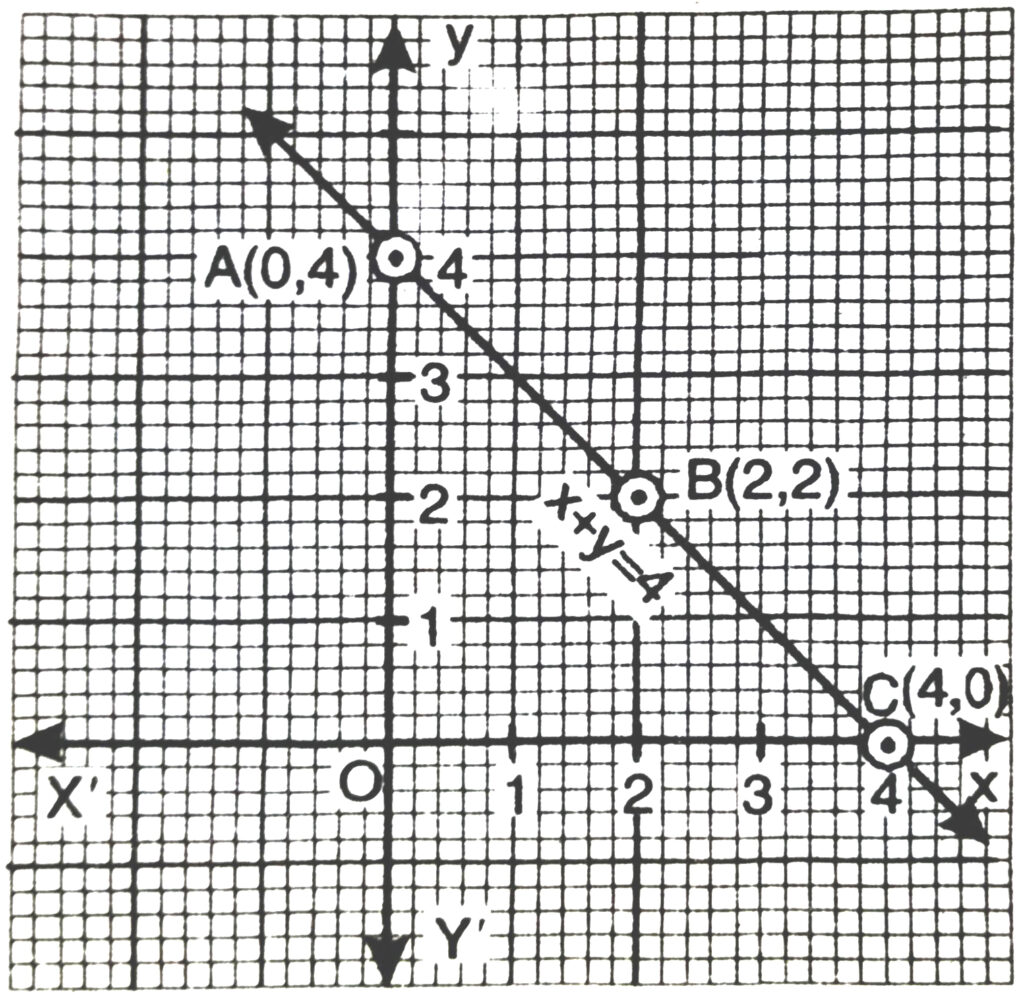
(ii) x – y = 2
⇒ -y = 2 – x
or y = x – 2
Table showing the value of y corresponding to the value of x is as follows :
| x | 0 | 1 | 2 |
| y | -2 | -1 | 0 |
| (x, y) | P (0, -2) | Q (1, -1) | R (2, 0) |
Plot the points P(0, 2), Q (1, – 1) and R (2, 0) on a graph paper.
Join these points and obtain a line.
Scale chosen :
On X – axis :
5 division = 1 unit
On Y – axis :
5 division = 1 unit
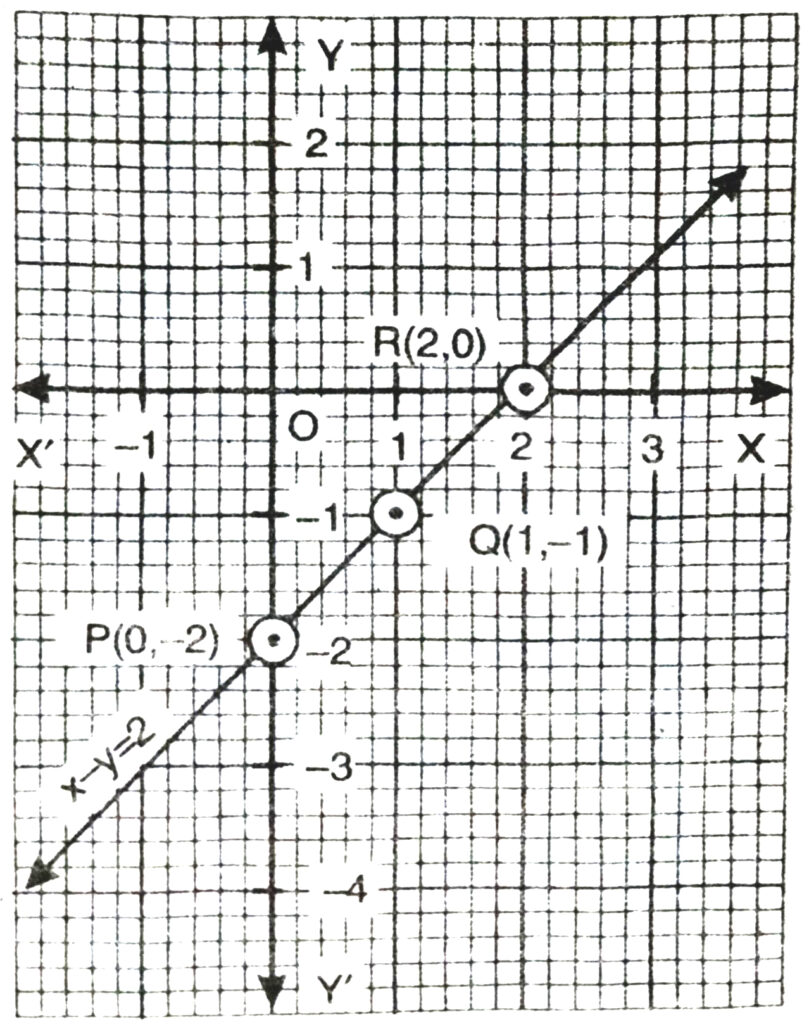
(iii) y = 3x
Table showing the value of y corresponding to the value of x is as follows :
| x | -1 | 0 | 1 |
| y | -3 | 0 | 3 |
| (x, y) | P (-1, -3) | Q (0, 0) | R (1, 3) |
Plot the points P(-1, -3), Q(0, 0) and R(1, 3) on a graph paper.
Join these points and obtain a line.
Scale chosen :
On X – axis
5 division = 1 unit
On Y – axis
5 division = 1 unit
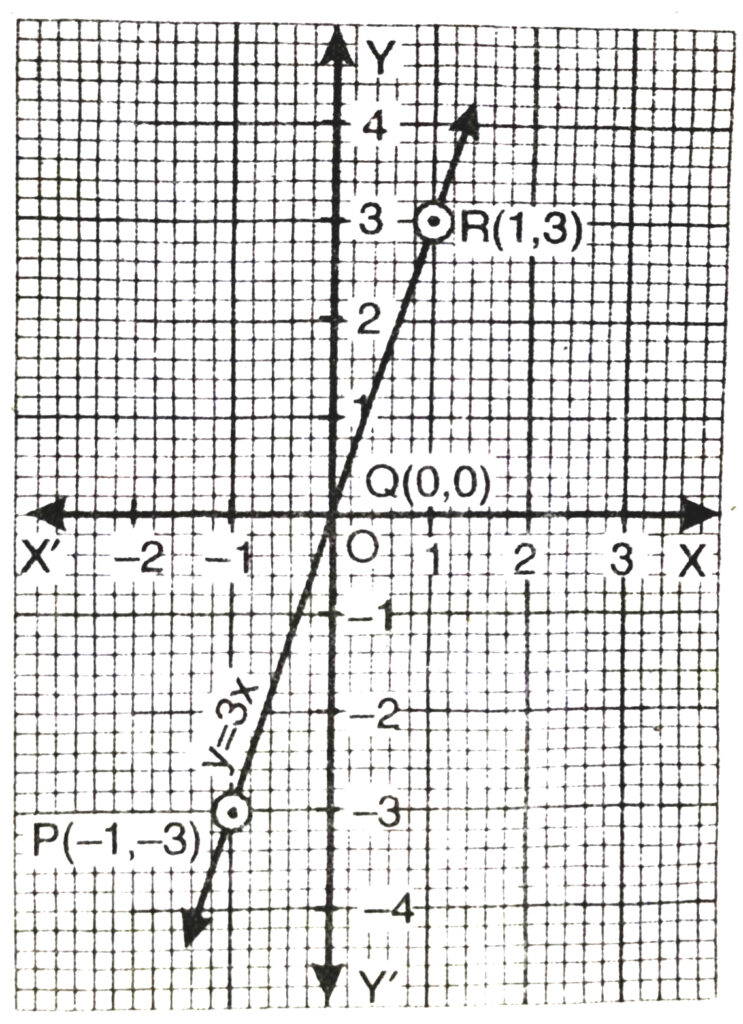
(iv) 3 = 2x + y
⇒ 3 – 2x = y
or y = 3 – 2x
Table showing the value of y corresponding to the value of x is as follows :
| x | 0 | 1 | 2 |
| y | 3 | 1 | -1 |
| (x, y) | L (0, 3) | M (1, 1) | N (2, -1) |
Plot the points L(0, 3), M (1, 1) and N(2, – 1) on a graph paper.
Join these points and obtain a line.
Scale chosen :
On X – axis :
5 division = 1 unit
On Y – axis :
5 division = 1 unit
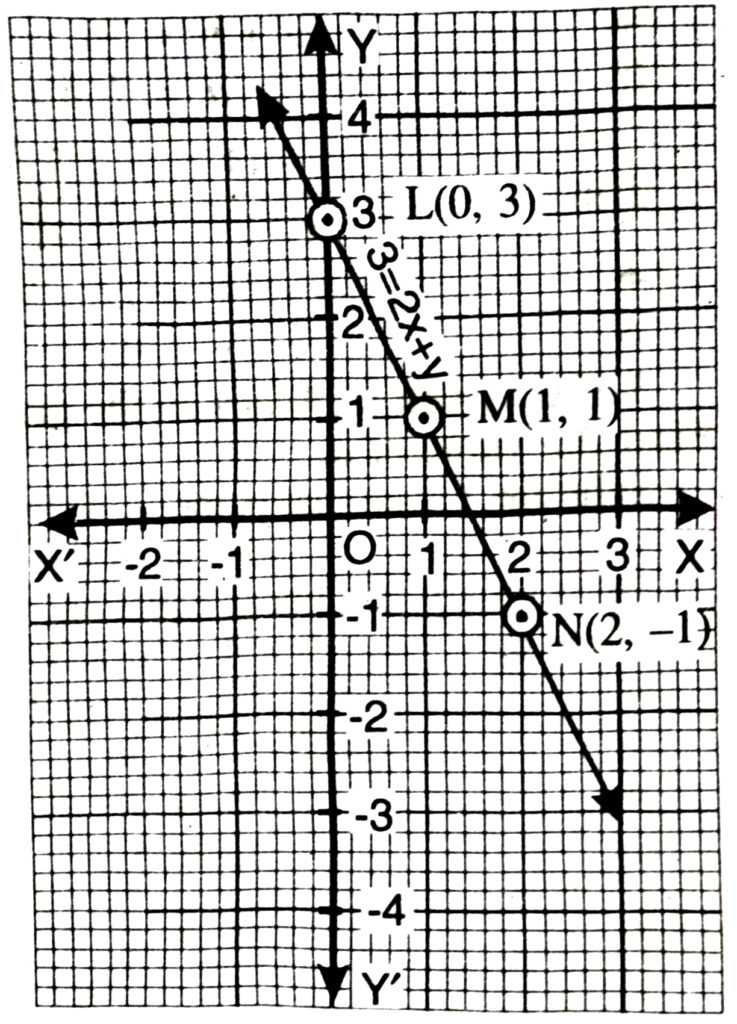
2. Give the equations of two lines passing through point (2, 14). How many more such lines are there and why ?
Solution.— As we know that through a point, infinitely many lines can be drawn. So out of these; any two linear equations which are satisfied by the point (2, 14) are as follows :
Let ax + by = c be linear equation in x and y which is satisfied by the point (2, 14).
It means (2, 14) lie on it :
∴ 2a + 14b = C
Substituting the value of c in equation, we get :
ax + by = 2a + 14b
⇒ a (x – 2) + b (y – 14) = 0
⇒ b (y – 14) = -a (x – 2)
⇒ y – 14/x – 2 = -a/b
By using different values of a and b, we can find the infinitely many required equations.
If a = 2, b = 1
then y – 14/ x – 2 = -2/1
⇒ y – 14 = -2x + 14
⇒ 2x + y = 18
If a = 7, b = -1
then y – 14/x – 2 = -{7/-1}
⇒ y – 14 = 7x – 14
⇒ 7x – y = 0.
3. If the point (3, 4) lies on the graph of the equation 3y = ax + 7, Find the value of a.
Solution.— Given that point (3, 4) lie on the graph corresponding to :
3y = ax + 7
So, it satisfy this linear equation.
There by 3 × 4 = a × 3 + 7
⇒ 12 = 3a + 7
⇒ 12 – 7 = 3a
⇒ 5 = 3a
or 3a = 5
⇒ a = 5/3
Hence, required value of a is 5/3.
Justification : Substitute,
a = 5/3 in given equation, we get :
3y = 5/3 x + 7
⇒ y = 5x + 21/9
Table showing the value of y corresponding to the value of x is as follows :
| x | -6 | 12 |
| y | -1 | 9 |
| (x, y) | P (- 6, -1) | Q (12, 9) |
Plot the points P(-6, -1) and Q (12, 9) on a graph paper. Join these points and obtain a line. From the graph, we observe that point (3, 4) lies on the line. Hence it satisfies the equation,
3y = 5/3 x + 7
Therefore found value 5/3 of unknown a correct. Hence justified.
Scale chosen :
On x- axis
5 division = 2 units
On y – axis
5 division = 1 unit
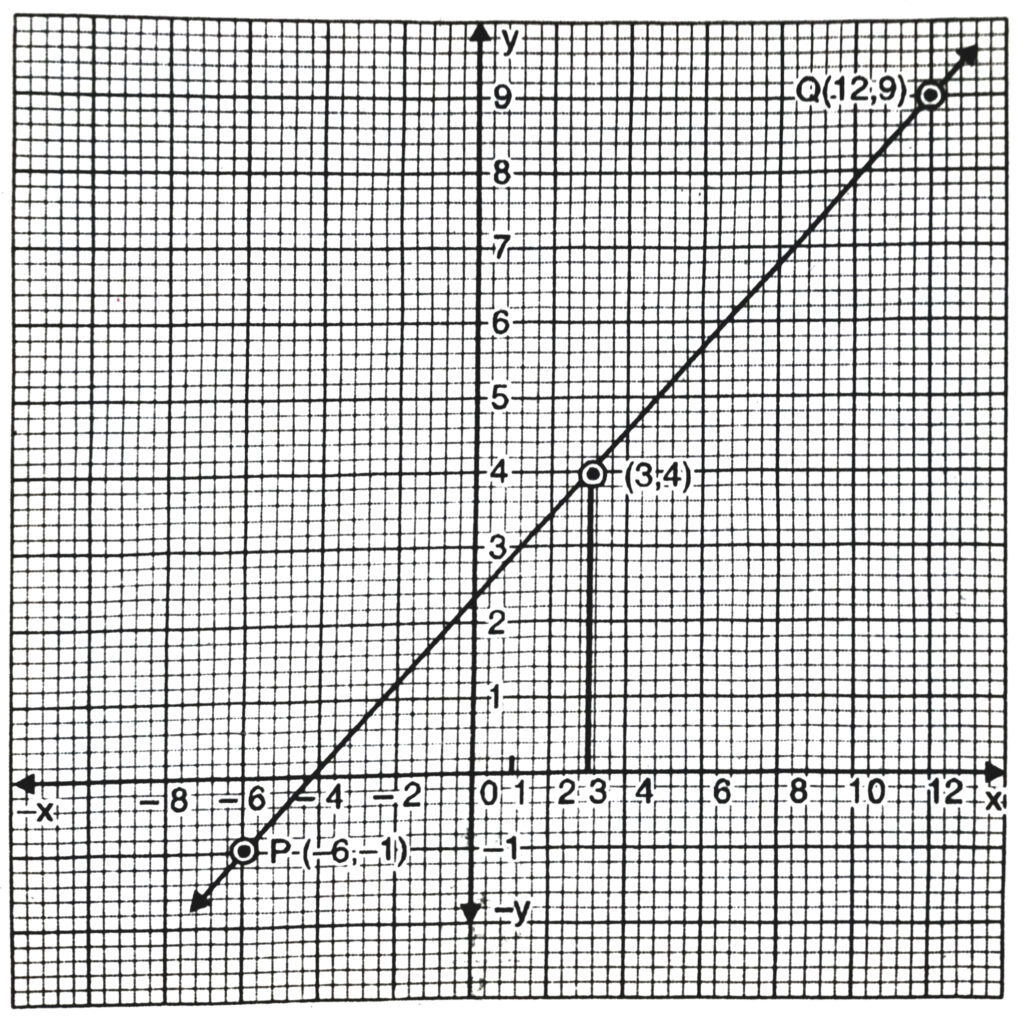
4. The taxi fare in a city is as follows: For the first kilometre, the fare is ₹8 and for the subsequent distance it is ₹5 per kilometre. Taking the distance covered as x km and total fare as ₹y, write a linear equation for this information and draw its graph.
Solution.—
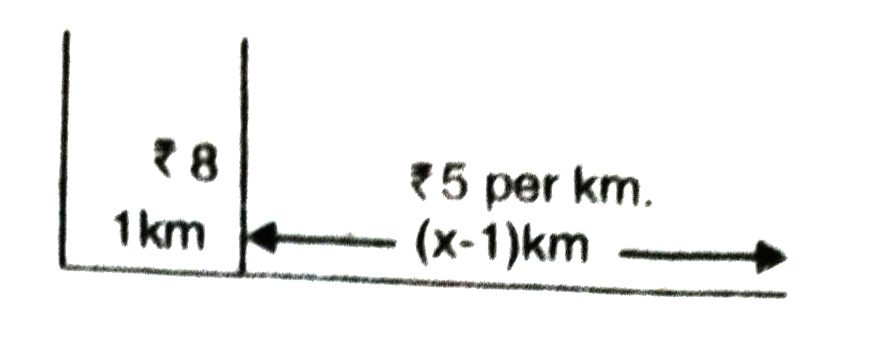
Taking total distance travelled as x km.
For first kilometre ; fare = ₹ 8
For subsequent distance i.e. for remaining distance ;
fare per kilometre = ₹ 5
∴ fare for remaining (x – 1) km
= ₹ 5(x – 1)
Total fare = ₹ y
∴ ₹ 8 (x – 1) = y
= 8 + 5 (x – 1) = y
= 5x + 3 = y
= 5x – y + 3 = …(1)
a liner equation for the given information. To plot the graph of equation (1) the table showing the value of y corresponding to the value of x is as follows :
| x | 1 | 2 |
| y | 8 | 13 |
| (x, y) | P (1, 8) | Q (2, 13) |
Plot the points P (1, 8), Q (2, 13) on the graph paper.
Join these points and obtain line.
Scale chosen on x – axis
5 division = 1 km
On y – axis
5 division = Re. 1
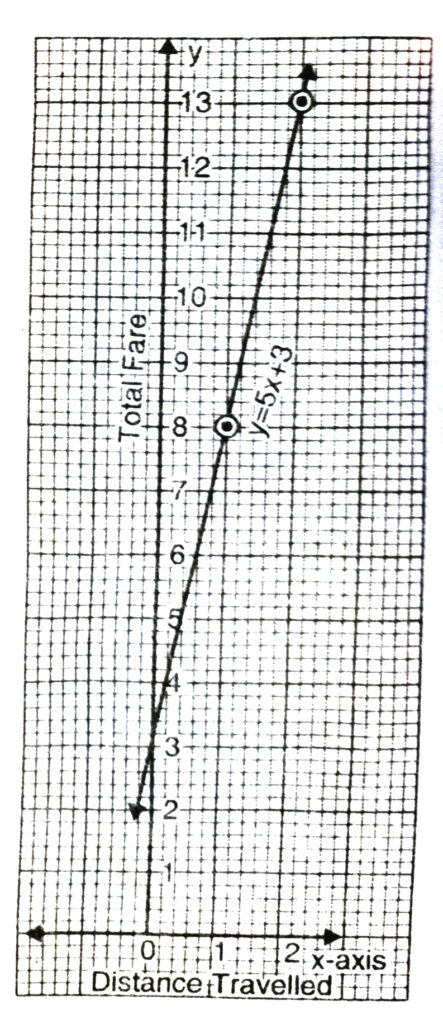
5. From the choices given below, choose the equation whose graph are given in Fig. (a) and Fig. (b).
For fig. (a) For fig. (b)
(i) y = x (i) y = x + 2
(ii) x + y = 0 (ii) y = x – 2
(iii) y = 2x (iii) y = – x + 2
(iv) 2 + 3y = 7x (iv) x + 2y = 6.
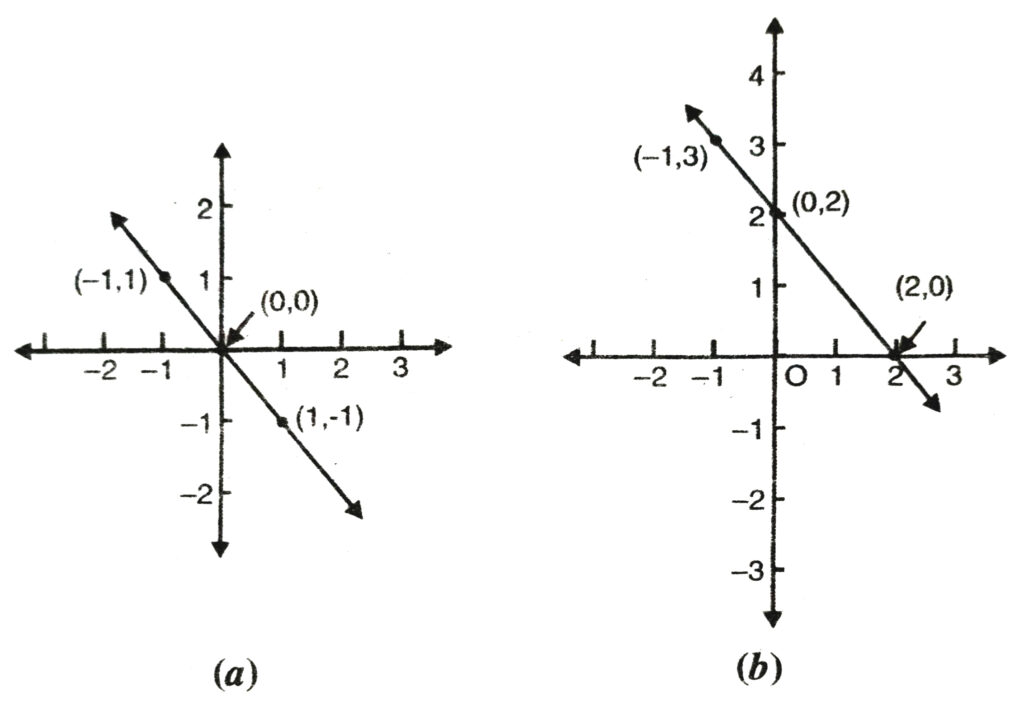
Solution.— Every point on the graph (a) is satisfied in the equations is :
(ii) x + y = 0
Therefore, for graph (a) the correct equation out of four equations is
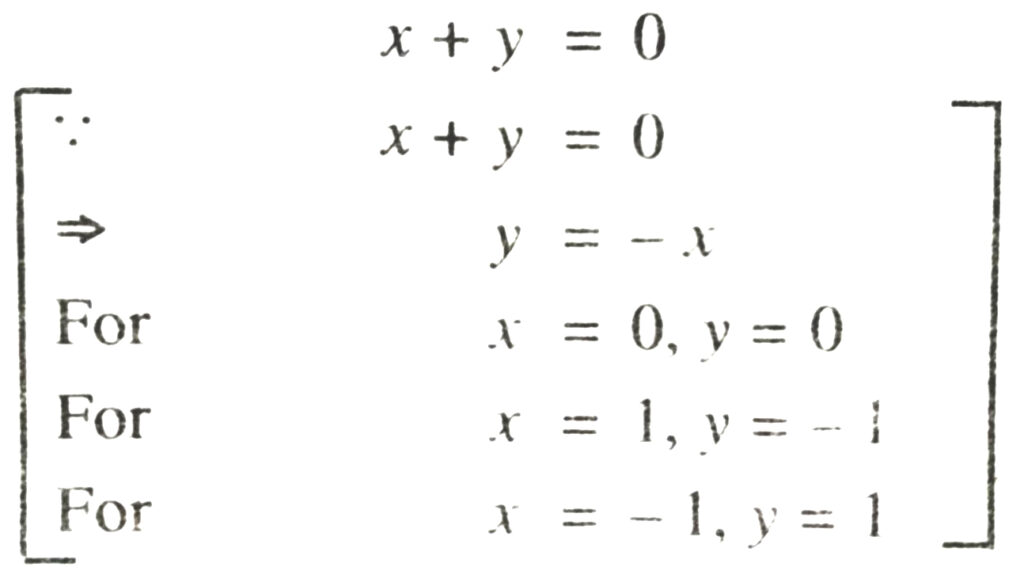
Now, every point on the graph (b) is satisfied in the equation
(iii) y = -x + 2
Therefore, for graph (b) the correct equation out of four equations is
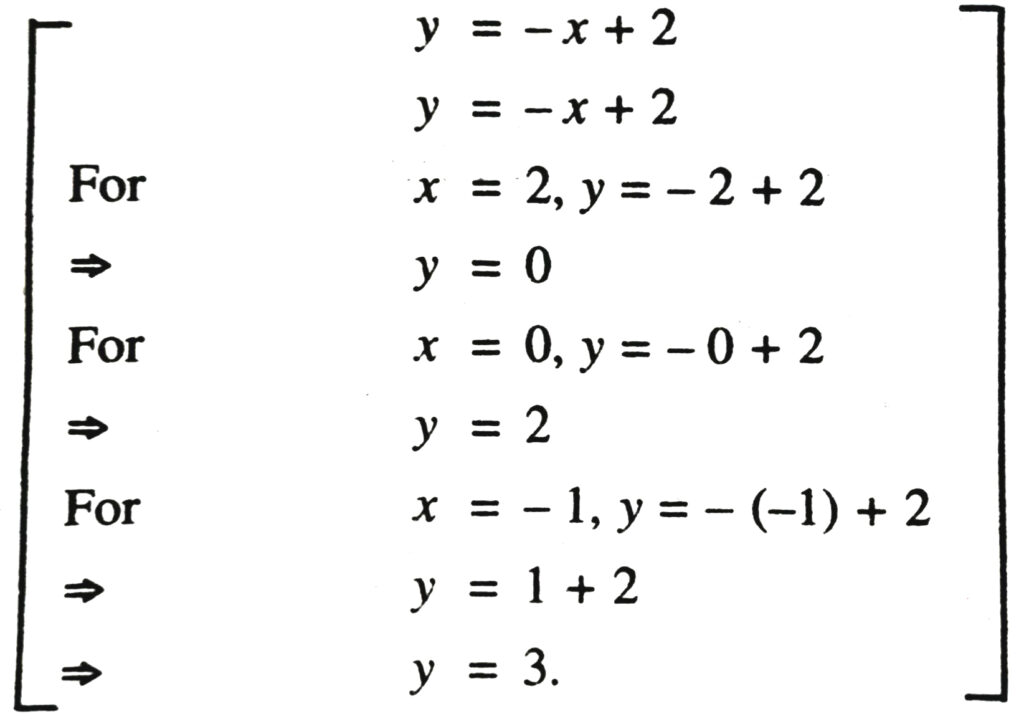
6. If the work done by a body on application of a constant force is directly proportional to the distance travelled by the body, express this in the form of an equation in two variables and draw the graph of the same by taking the constant force as 5 units. Also read from the graph the work done when the distance travelled by the body is :
(i) 2 units (ii) 0 unit.
Solution.— Let work done by constant force (say k units) is y units and distance travelled by the body is x units. As we know that work done by a force is directly proportional to the distance travelled by the body.
From ratio and proportion; we can express this fact as :
y = kx
Taking
k = 5 units
∴ y = 5x (1)
which is a linear equation in two variables.
To plot the graph of equation (1); the table showing the value of y corresponding to the values of x is as follows :
| x | 1/2 | 1 | 3 |
| y | 5/2 | 5 | 15 |
| (x, y) | P(1/2, 5/2) | Q(1, 5) | R (3, 15) |
Plot the points P (1/2, 5/2), Q (1, 5) and R (3, 15) on graph paper.
Join these points and obtain the line.
Scale chosen :
On x-axis
5 divisions = 1unit distance moved
On y-axis
5 divisions = 1unit work done
From the graph, we observe that when
(i) x = 2 units
then y = 10 units
Hence, when distance moved bythe body is 2 units then work done is 10 units.
(ii) When x = 0 units
then y = 0 units
Hence, when no distance is moved by the body then no work is done on body.
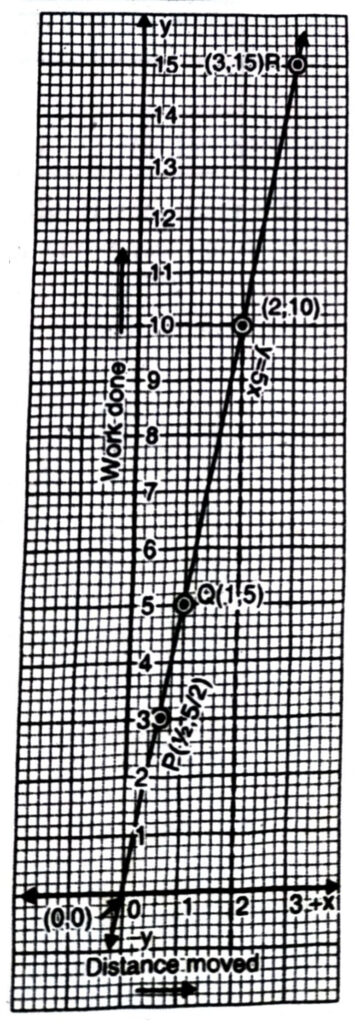
7. Yamini and Fatima, two students of Class IX of a school, together contributed ₹ 100 towards the Prime Minister’s Relief Fund to help the earthquake victims. Write a linear equation which satisfies this data. (You may take their contribution as ₹ x and ₹ y.) Draw the graph of the same.
Solution.— Let Yamini contributed ₹ x and Fatima contributed ₹ y towards Prime Minister’s Relief Fund. Contribution of both = ₹ 100
⇒ x + y = 100 …(i)
which is a linear equation in two variables.
To plot the graph of equation (1); we draw the table showing the values of y corresponding to the values of x.
| x | 40 | 50 | 70 |
| y | 60 | 50 | 30 |
| (x, y) | P (40, 60) | Q (50, 50) | R (70, 30) |
Plot the points P (40, 60), Q (50, 50) and R (70, 30) on a graph paper. Join these points and obtain a line.
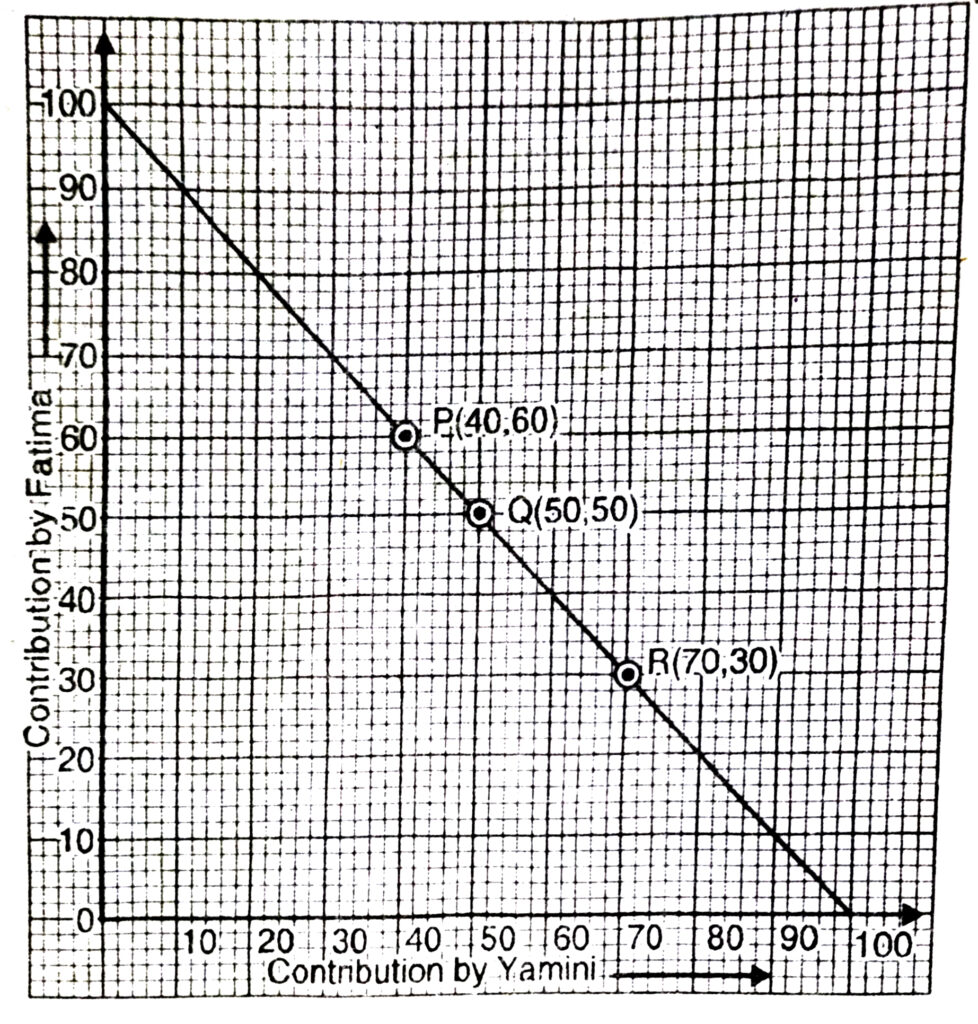
8. In countries like the USA and Canada, temperature is measured in Fahrenheit, whereas in countries like India it is measured in Celsius. Here is a linear equation that converts Fahrenheit to Celsius :
F = {9/5} C + 32
(i) Draw the graph of above linear equation using Celsius for x-axis and Fahrenheit for y-axis.
(ii) If the temperature is 30°C, what is the temperature in Fahrenheit?
(iii) If the temperature is 95°F, what is the temperature in Celsius ?
(iv) If the temperature is 0°C, what is the temperature in Fahrenheit and if the temperature is 0°F, what is the temperature in Celsius ?
(v) Is there a temperature which is numerically the same in both Fahrenheit and Celsius? If yes, find it ?
Solution.— (i) Linear equation in two variables; °F (Fahrenheit) and °C (Celsius) is :
F = {9/5} C + 32 …(1)
To plot the graph of equation (1) we draw the table showing the values of F corresponding to the values of C.
| C | 0 | – 20 |
| F | 32 | – 4 |
| (C, F) | (0, 32) | (- 20, – 4) |
Plot the points (0, 32) and (-20, -4) on a graph. Join these points and obtain a line.
(ii) From the graph; if temperature is 30°C, then temperature in Fahrenheit is 86°F.
(iii) From the graph; if temperature is 95°F then temperature in celsius is 35°C.
(iv) From the temperature graph; if is 0°C then temperature in Fahrenheit is 32°F. If temperature is 0°F, then temperature in celsius is – 17.8°C (approximately).
(v) Yes; there is a temperature which is numerically same in both Fahrenheit and Celsius. From the graph we observe that point (-40, 40) lie on line.
Hence – 40° (both in F and C) is numerically the same temperature.
[Note: -40°F ≠ -40°C].
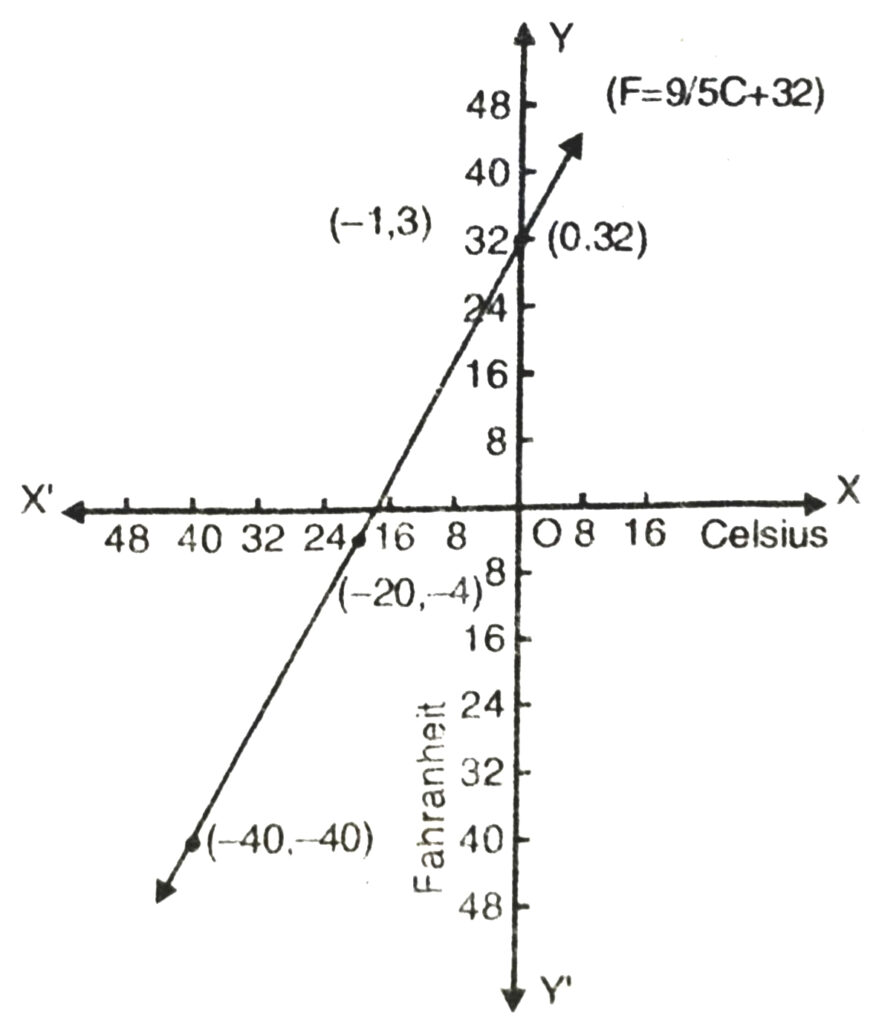
TEXT BOOK EXERCISE – 3.4
1. Give the geometric representation of y = 3 as an equation
(i) in one variable
(ii) in two variable
Solution.— (i) y = 3 in terms of two variables is represented in Cartesian co-ordinate system.

(ii) y = 3 in terms of two variables is represented in Cartesian co-ordinate system.
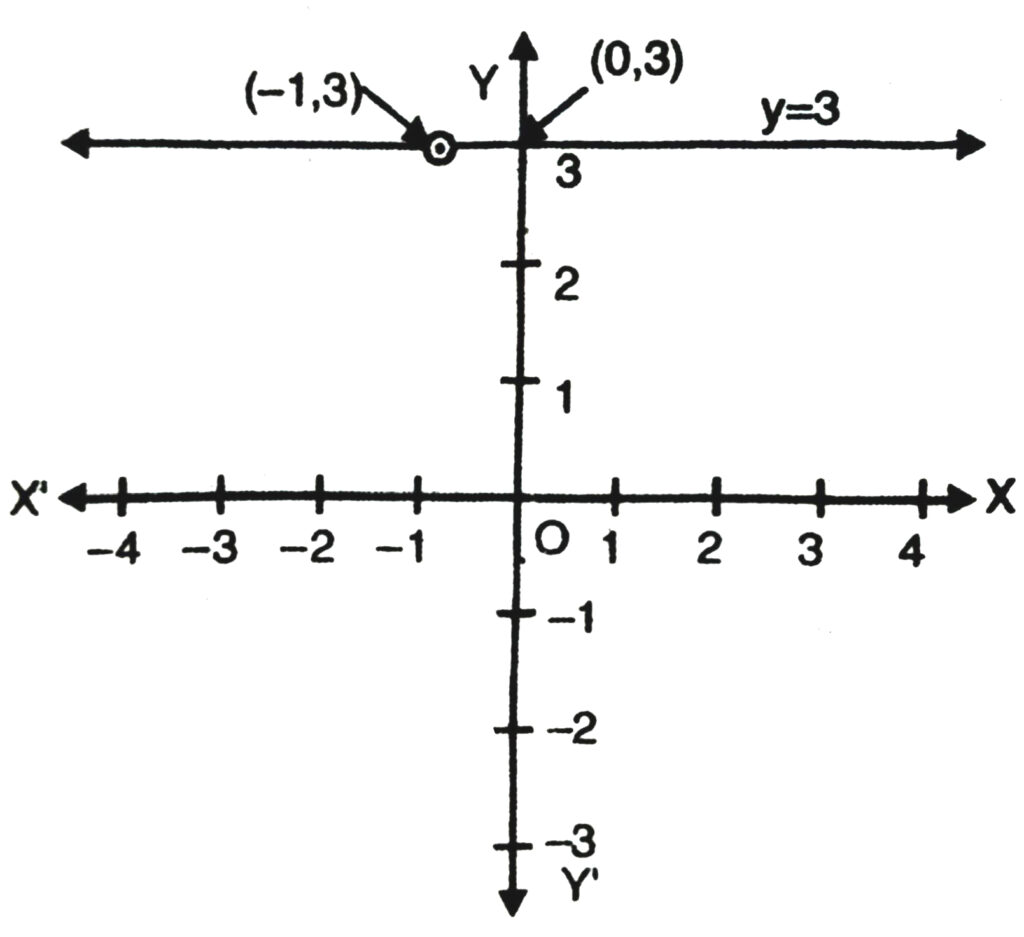
2. Give the geometric representation of 2x + 9 = 0 as an equation
(i) in one variable.
(ii) in two variables.
Solution.— (i) 2x + 9 = 0 in terms of one variable is represented on number line :
2x + 9 = 0
⇒ 2x = – 9
⇒ x = -9/2

(ii) 2x + 9 = 0
i.e. x = -9/2 in terms of two variables is represented in Cartesian coordinate system :
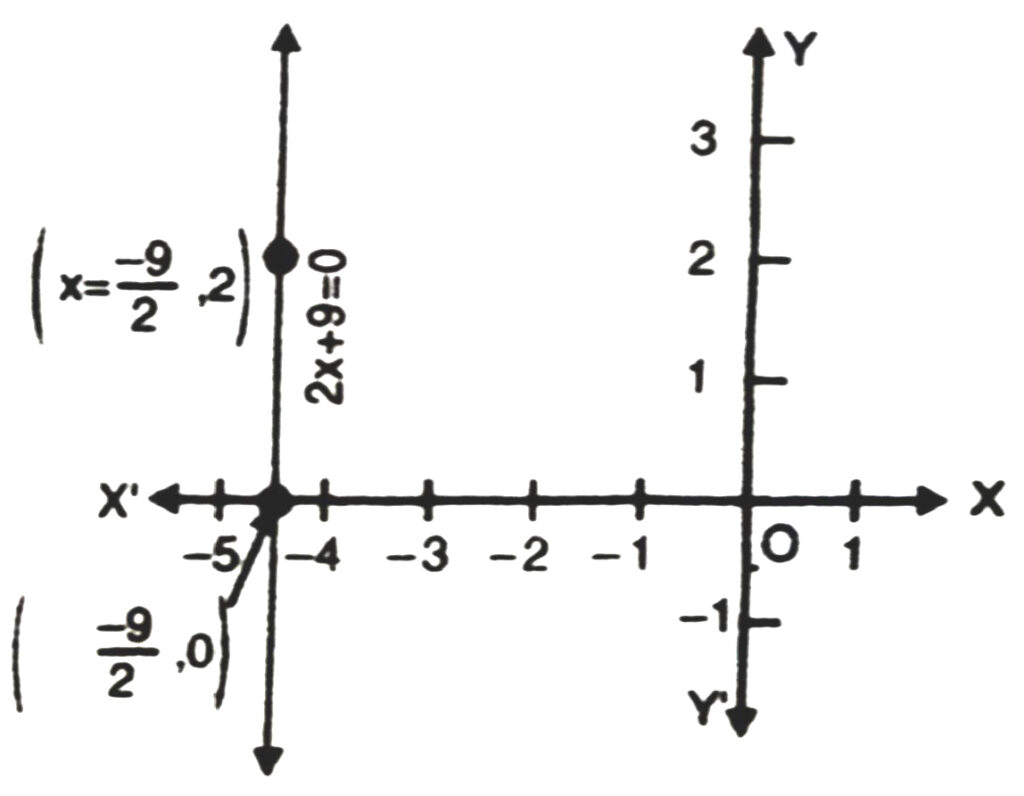
Follow on Facebook page – Click Here
Google News join in – Click Here
Read More Asia News – Click Here
Read More Sports News – Click Here
Read More Crypto News – Click Here